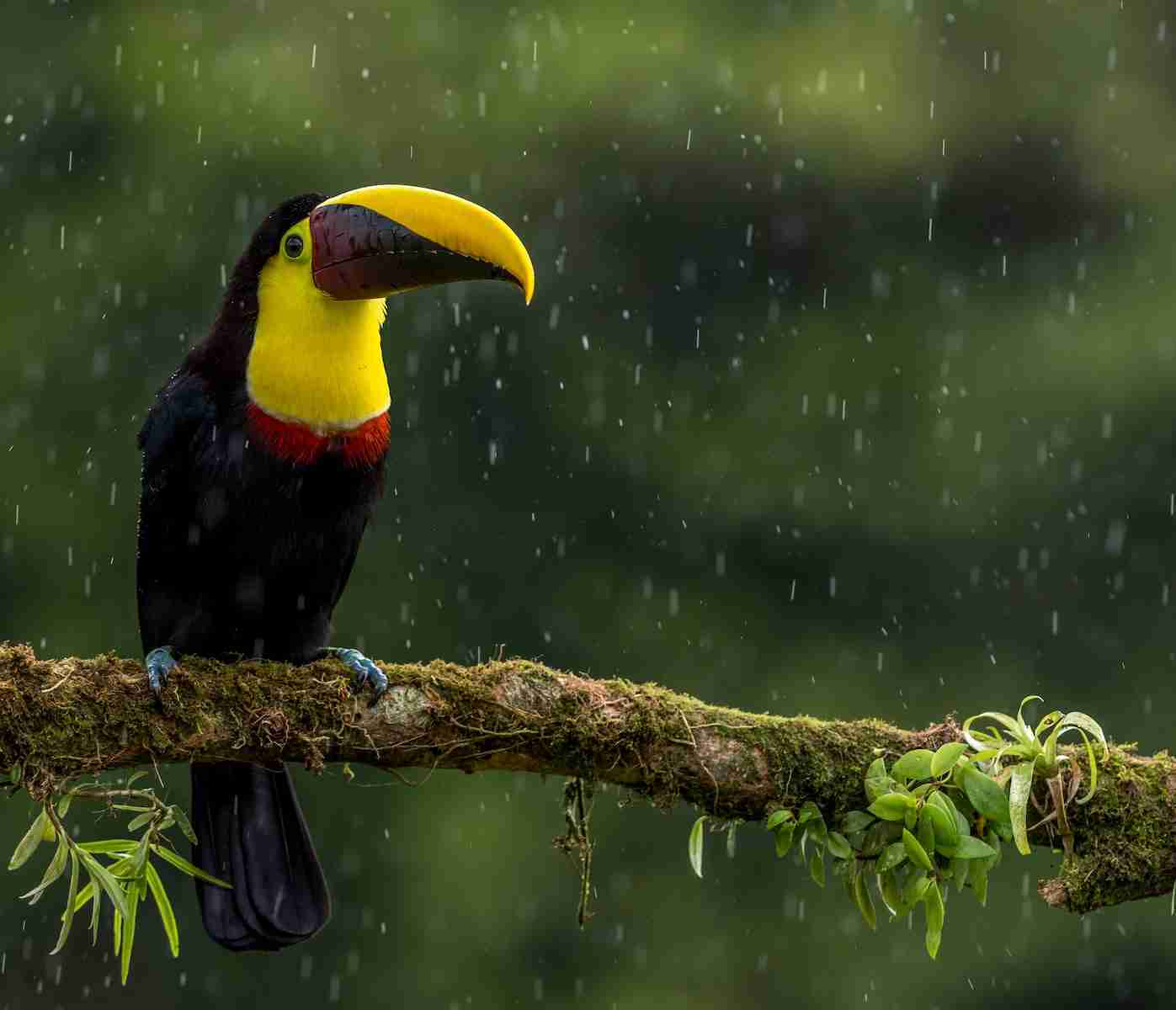25 Interesting Facts About Toucans That You Didn’t Know
1. Toucans are a type of bird that belongs to the family Ramphastidae.
Toucans are a colorful and distinctive group of birds that are known for their large bills. They are part of the Ramphastidae family, which includes other bird species such as aracaris and toucanets.
Toucans are found in Central and South America, where they inhabit forests and woodlands.
2. The toucan family includes 50 species.
There’s a vibrant cast of characters in the toucan family. With over 50 unique species, these rainforest residents come in a stunning array of colors and sizes. Sadly, 11 of these feathered friends are facing threats like habitat loss.
Hunting and the illegal pet trade also pose dangers. Some particularly vulnerable species include the Curl-crested Aracari, with its distinctive head feathers, and the aptly named Chestnut-eared Aracari, known for its reddish ear patches.
3. Toucans are native to Central and South America.
Toucans are found throughout Central and South America, from Mexico to Argentina.
They are particularly common in tropical rainforests, where they play an important role in the ecosystem as seed dispersers.
Toucans have also adapted to living in other types of habitats, including savannas and woodlands.
4. The smallest toucan species is called the Aracari.
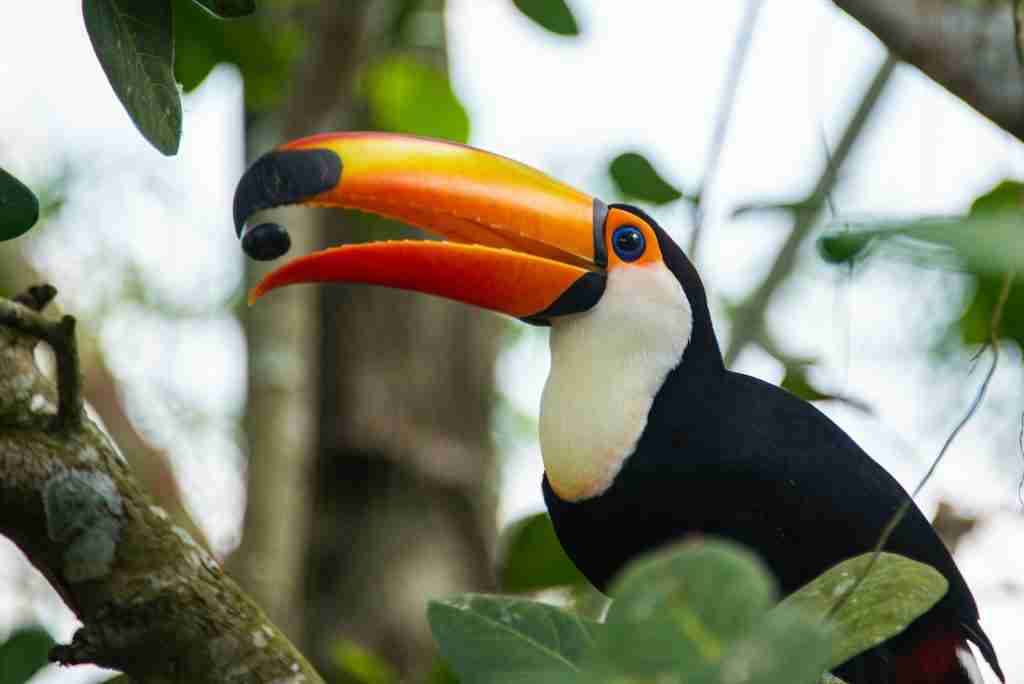
The title holder for the smallest toucan is the lettered aracari, a tiny bird that weighs a mere 130 grams (about the weight of a tennis ball) and measures only 29 centimeters long.
That’s compact enough to fit comfortably in your hand. In comparison, the giant toco toucan can weigh over 680 grams, making the lettered aracari a true featherweight.
5. Toucan bills are made of keratin, the same material that makes up human hair and nails.
The toucan’s bill is made of keratin, a tough, fibrous protein also found in human hair and nails.
This material is lightweight but strong, which makes it well-suited for the toucan’s needs.
The bill is not just a tool for feeding; it also helps the bird regulate its body temperature and is used in displays to attract mates.
6. A constellation named after the toucan is called the Tucana.
Look up at the southern sky, and you might spot Tucana, a constellation named after the toucan, a vibrantly colored bird with a massive beak. This compact constellation is home to Alpha Tucanae, its brightest star, and a fascinating neighbor.
The Small Magellanic Cloud, a dwarf galaxy just 190,000 light-years away – one of our Milky Way’s closest companions. Interestingly, the lettered aracari, the tiniest toucan species, weighs a mere 130 grams, about the weight of a tennis ball.
7. Toucans use their bills to pluck fruit from trees and to reach insects.
Toucans are omnivores and eat a variety of foods, including fruit, insects, and small animals.
Their bill is an essential tool for feeding, as they use it to pluck fruit from trees and to reach insects hiding in tree bark.
The bill is also used for social communication, as toucans often clack their bills together to establish dominance or attract mates.
8. The average toucan’s bill can be a whopping third of its entire body length.
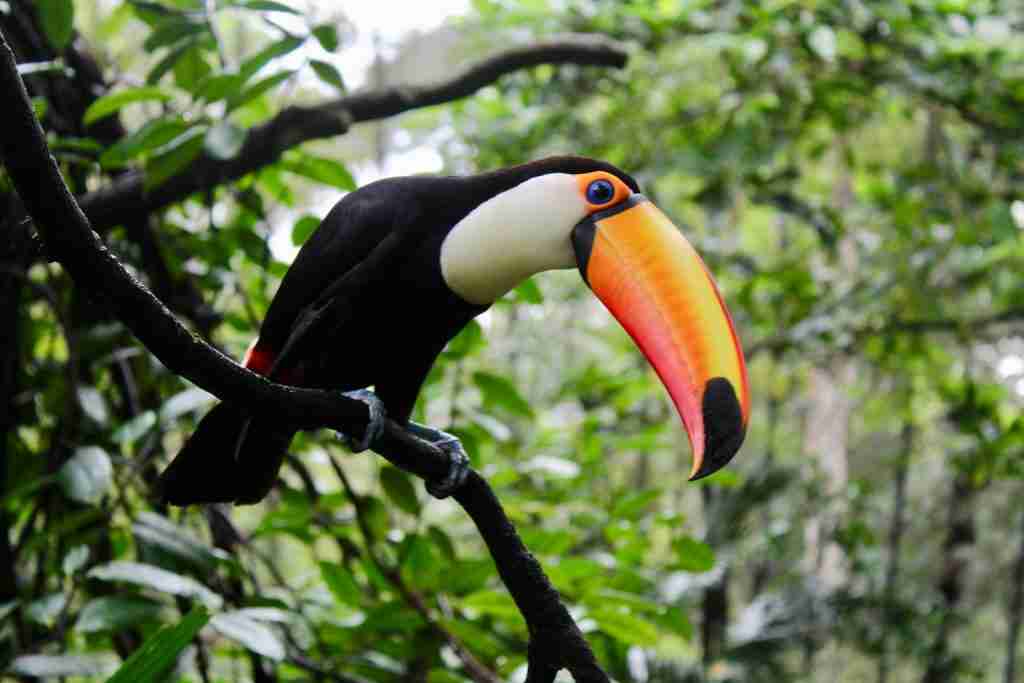
Toucans are all beaks, with their colorful bills reaching a whopping 7 inches (18 cm) long—that’s a third of their entire body. Surprisingly, these impressive appendages are lightweight, thanks to a honeycomb-like structure.
Despite their size, they only contribute a tiny fraction (around 3%) to a toucan’s overall weight of 13-18 ounces (380-500 grams).
9. Toucans are social birds and often travel in flocks.
Toucans are social birds and are often found in flocks, especially during the non-breeding season. Flocks can range in size from just a few birds to over a dozen individuals.
Toucans communicate with each other through a variety of vocalizations, including croaks, yelps, and barks.
10. Male and female toucans have similar physical characteristics.
In most species of toucans, male and female birds have similar physical characteristics, making it difficult to tell them apart by appearance alone.
However, males and females may exhibit slight differences in bill size or coloration. In some species, such as the chestnut-mandibled toucan, males have larger bills than females.
11. Toucans are monogamous and mate for life.
Toucans are monogamous birds that mate for life. Once a pair forms a bond, they remain together for many years and may raise several broods of offspring together.
During courtship, toucans engage in a variety of displays, including bill-clacking, preening, and vocalizing.
12. The Toco Toucan is recognized as the largest species among toucans.
The undisputed heavyweight champ of toucans is the Toco Toucan. These rainforest giants clock in at an impressive 24 inches (61 cm) tall, with their bodies about the size of a crow’s.
Despite their impressive beaks, swans only weigh 1.5 to 2 pounds (550-800 grams) due to their lightweight bone structure.
Toco Toucans are social butterflies. They typically live in pairs or small groups and spend their days flitting through the trees in search of tasty fruit.
13. Toucans are important seed dispersers in tropical rainforests.
Toucans play an important role in the ecology of tropical rainforests, as they are key seed dispersers.
They eat a variety of fruit and then disperse the seeds throughout the forest in their droppings.
This helps to ensure the survival and diversity of plant species in the forest.
14. Toucans have a unique digestive system that allows them to extract nutrients from tough plant material.
Toucans have a specialized digestive system that allows them to extract nutrients from tough plant material.
Their digestive tract is relatively long and contains a series of pouches that help break down tough fibers.
This enables toucans to extract more nutrients from their food than other birds.
15. Toucans are preyed upon by a variety of predators, including snakes and birds of prey.
Despite their large size and distinctive appearance, toucans are vulnerable to a variety of predators in their natural habitat.
Snakes, birds of prey, and other predators may prey upon toucans, especially chicks and young birds.
16. Toucans have a unique way of sleeping.
Toucans have a unique way of sleeping: They tuck their heads under their wings and rest their bills on their backs.
This allows them to conserve body heat and protect their bills from damage while they sleep.
17. Toucans have been kept as pets for centuries.
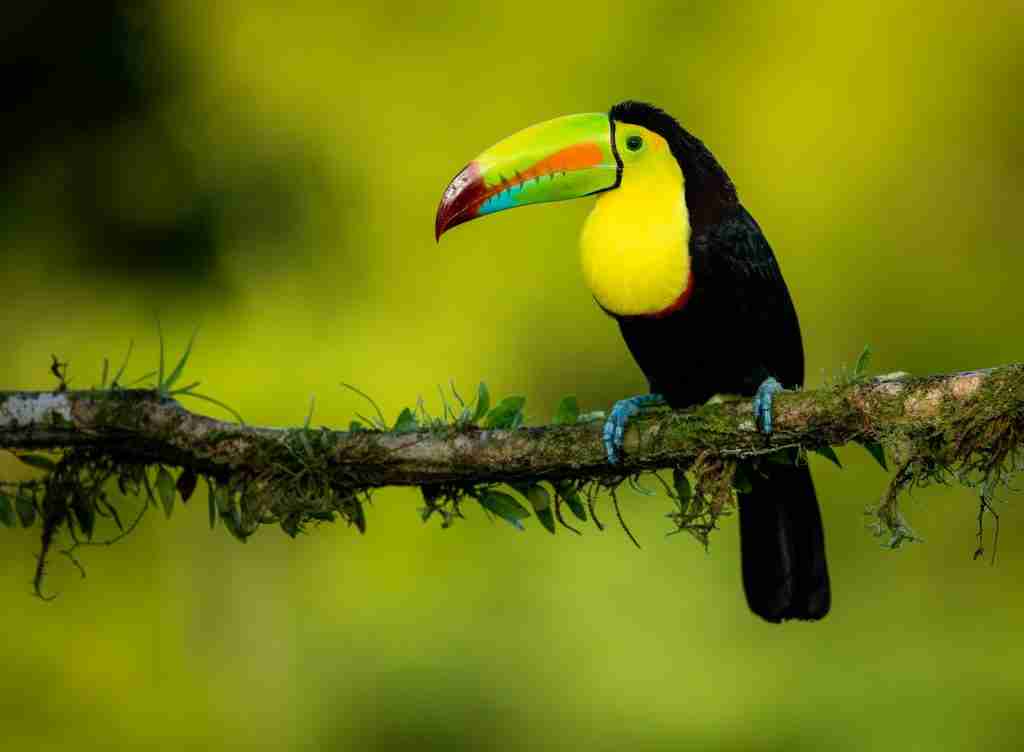
Toucans have been kept as pets for centuries and are popular among bird enthusiasts due to their distinctive appearance and lively personalities.
However, it is important to note that toucans are not suitable as pets for most people, as they require specialized care and a large amount of space.
18. Toucans are sometimes hunted for their feathers and meat.
In some parts of their range, toucans are hunted for their colorful feathers, which are used in traditional costumes and other cultural artifacts.
They are also sometimes hunted for their meat, although this is less common.
19. Toucans have been featured in popular culture, including movies and cartoons.
Toucans have been featured in various popular culture, including movies and cartoons. One of the most famous toucans is Toucan Sam, the mascot for Froot Loops cereal.
Toucans have also appeared in movies such as Rio and The Jungle Book.
20. Toucans are highly social birds that live in flocks.
Toucans are highly social birds that live in flocks of up to six individuals.
They communicate with each other using a variety of vocalizations, including grunts, croaks, and whistles.
21. The keel-billed toucan is the national bird of Belize.
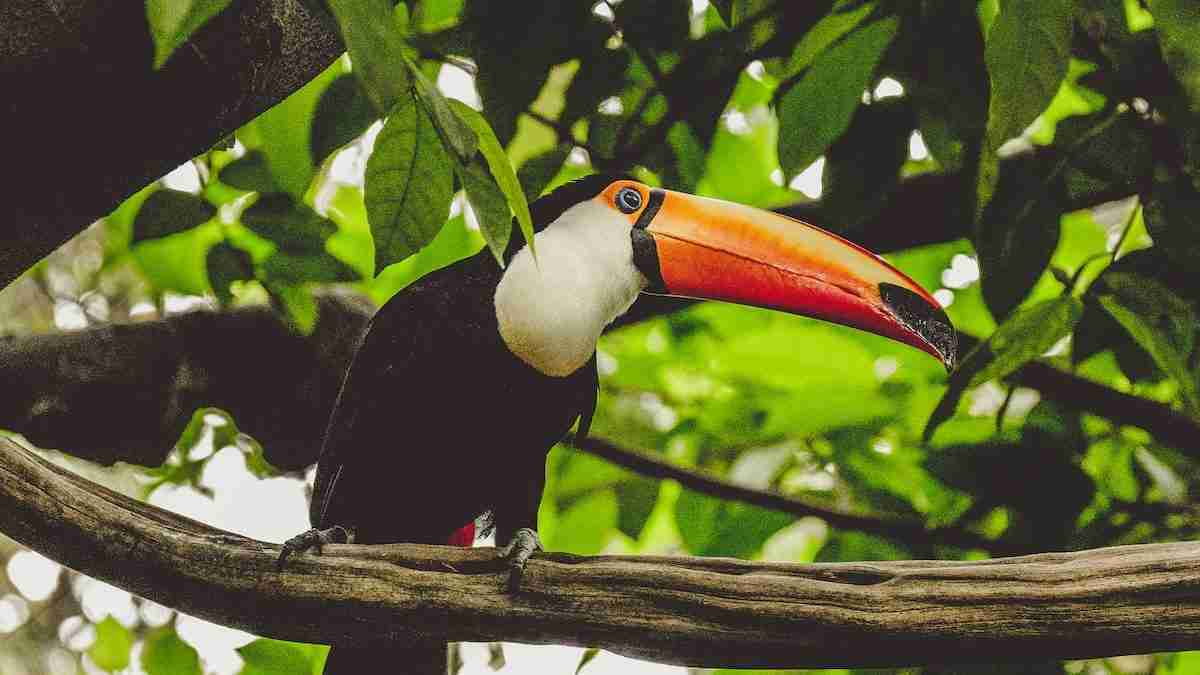
The keel-billed toucan, with its colorful bill and distinctive appearance, is the national bird of Belize.
It is featured on the country’s coat of arms and is a symbol of national pride.
22. Toucans are known for their playful behavior.
Toucans are known for their playful behavior and may engage in acrobatic displays and games with each other.
They have also been observed playing with objects such as sticks and toys.
23. Toucans and woodpeckers share several characteristics and are considered to be closely related.
Toucans and woodpeckers might seem like birds of a different feather, but they’re actually distant cousins. Both belong to the same bird order, Piciformes, and share some cool traits.
Their zygodactyl feet, with two toes pointing forward and two back, are perfect for gripping branches. They also tend to favor similar menus, enjoying a mix of insects and tasty fruit.
24. Toucans have been used in traditional medicine.
In some cultures, toucans have been used in traditional medicine to treat a variety of ailments.
Their feathers, bills, and other body parts have been used to make remedies for everything from headaches to snakebites.
25. Toucans are excellent climbers. They use their strong beaks to grip branches while hopping from one perch to another.
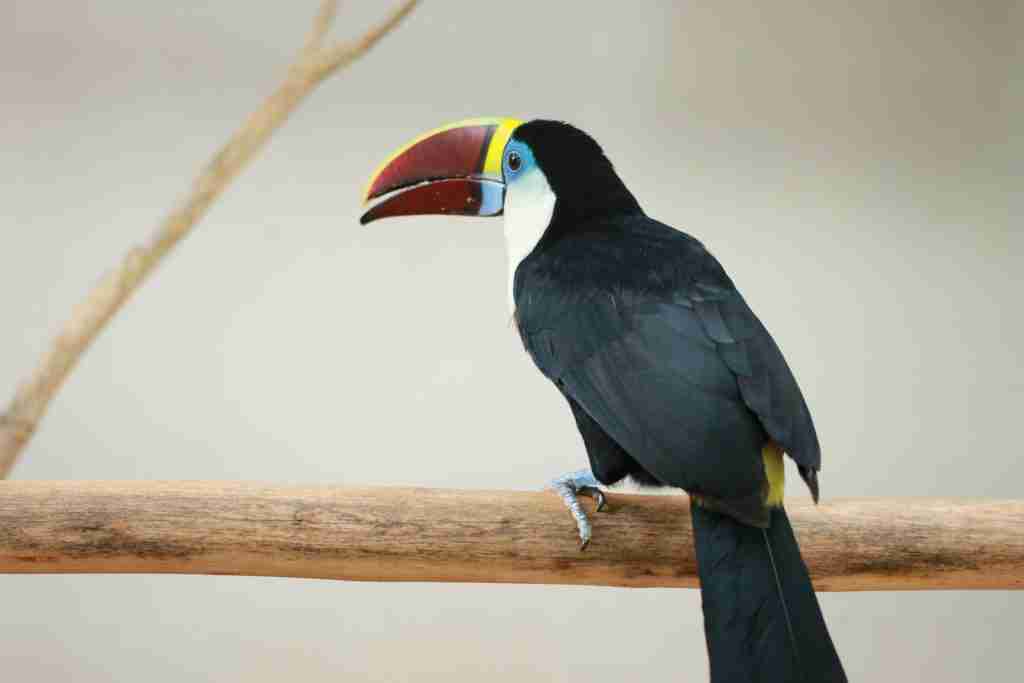
Toucans exhibit remarkable climbing abilities, leveraging their sturdy beaks to firmly grasp branches as they navigate through the dense canopy. With agile movements, they hop from one perch to another, displaying impressive balance and coordination.
Their strong beaks not only aid in gripping but also serve as versatile tools for foraging and manipulating objects in their environment. This unique adaptation allows toucans to access a variety of food sources and navigate their arboreal habitat with ease.
FAQS
Toucans primarily inhabit tropical and subtropical forests in Central and South America. They are found in countries such as Brazil, Colombia, Venezuela, and Ecuador, among others. These birds prefer dense, humid forests with a rich variety of fruit-bearing trees, where they can find ample food and suitable nesting sites.
Toucans are primarily frugivorous, meaning they mainly eat fruits. Their diet consists of a variety of fruits, including berries, figs, and tropical fruits like bananas and papayas. Additionally, toucans may also consume insects, small reptiles, eggs, and even small birds or nestlings on occasion. Their broad diet allows them to adapt to changes in food availability throughout their habitat.
Toucan species vary in their conservation status. While some species are considered of least concern, meaning they are not currently threatened, others face more significant conservation challenges. Factors such as habitat loss due to deforestation, illegal pet trade, and hunting can threaten toucan populations. Some species, like the Channel-billed Toucan, are classified as near-threatened due to habitat loss and fragmentation.
No, toucans are not parrots. While they are both types of birds and share some similarities, such as being found in tropical regions and having vibrant plumage, they belong to different families. Toucans belong to the family Ramphastidae, while parrots belong to the family Psittacidae. One key difference between them is their beaks: toucans have large, brightly colored beaks, while parrots have smaller, hook-shaped beaks.
Toucans have strong, sharp beaks that they use for various tasks such as feeding, grooming, and defending themselves. While toucans generally do not have aggressive tendencies towards humans, they may defend themselves by biting if they feel threatened or cornered. Toucan bites can potentially be painful due to the strength of their beaks and their sharp edges.

